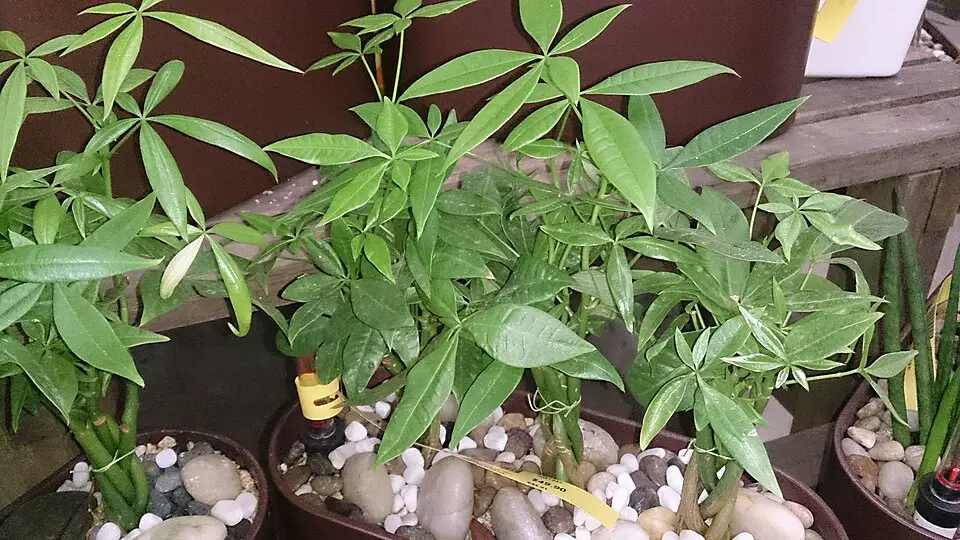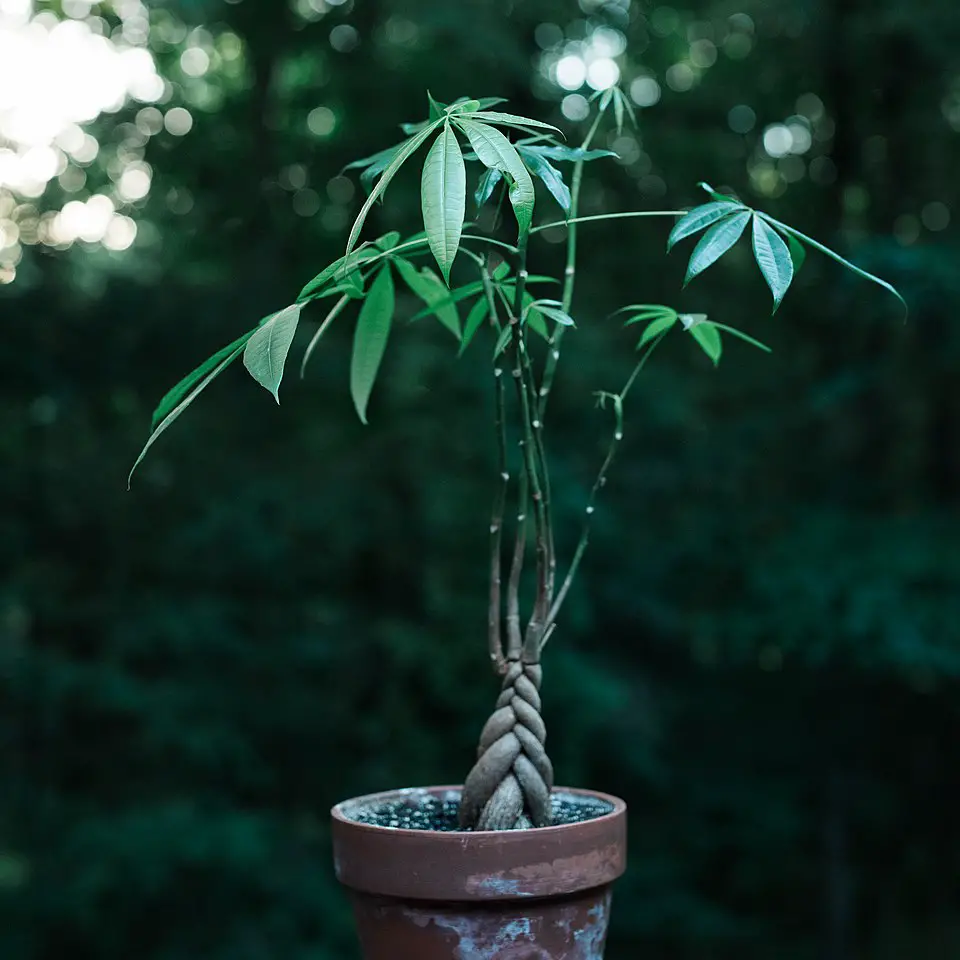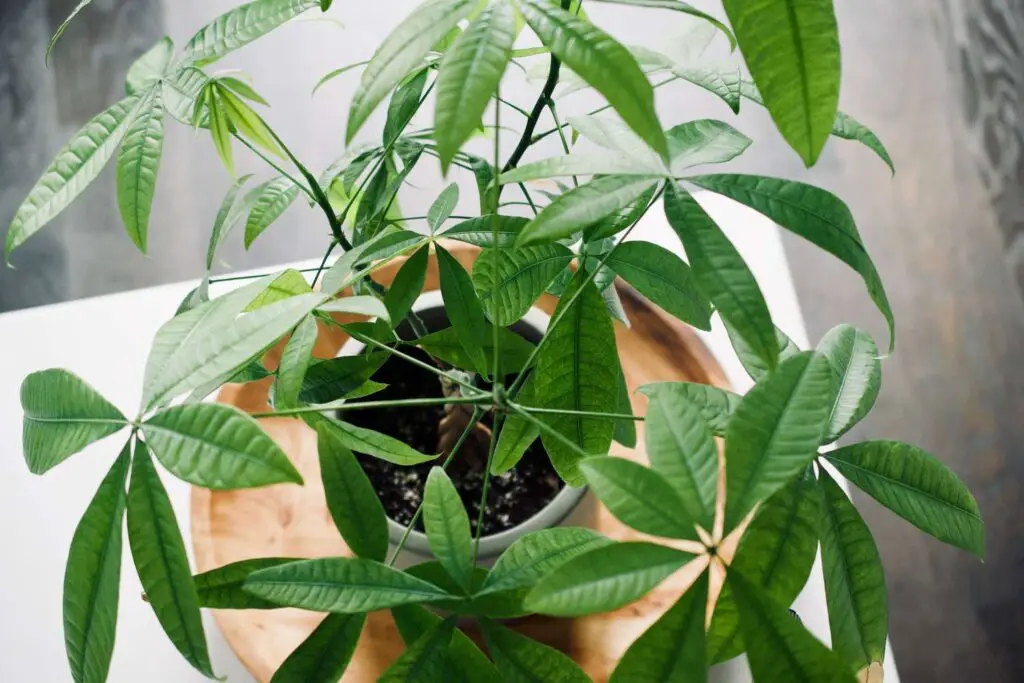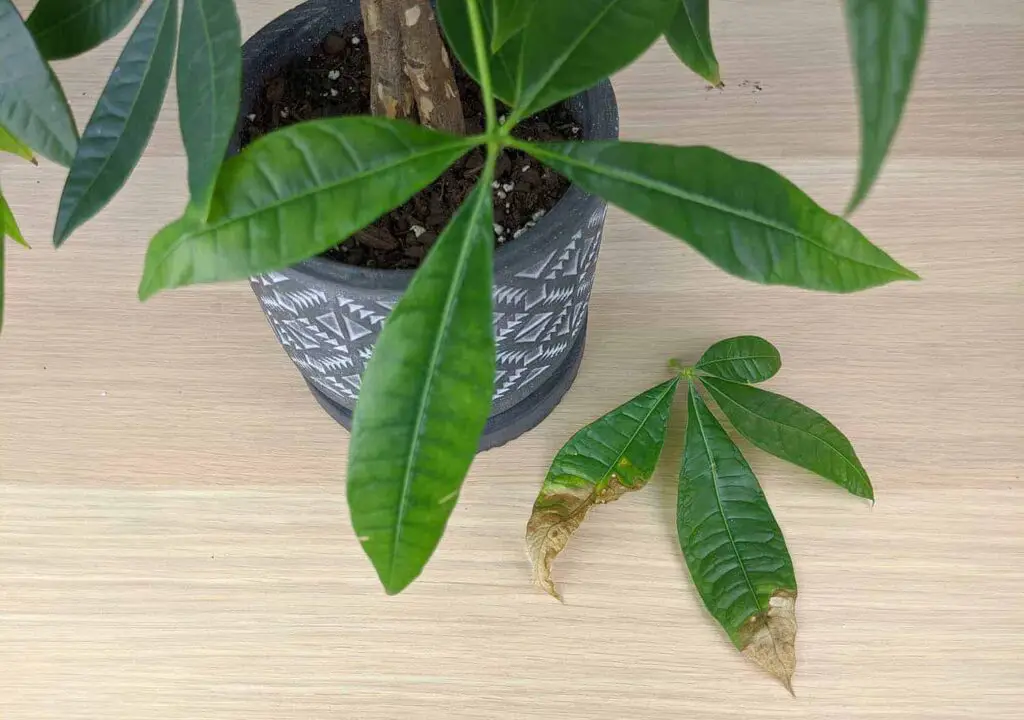To trim a money tree, prune any brown or yellowing leaves or branches using a clean pair of garden shears. The money tree, scientifically known as pachira aquatica, is a popular indoor plant with braided trunks that can reach five to six feet in height.
Native to central and south america, it requires minimal care and thrives in bright, indirect light. Trimming helps maintain its compact size and promotes healthy growth. We will discuss the step-by-step process to trim a money tree, including the tools needed, the best time to trim, and how to properly prune the plant to ensure its health and longevity.

Whether you are a seasoned gardener or a beginner, this guide will provide you with all the information you need to care for your money tree. So let’s get started!
Understanding The Money Tree Plant
Overview Of The Money Tree Plant
The money tree plant, also known as pachira aquatica, is a popular choice among indoor plant enthusiasts. With its distinctive braided trunk and vibrant green leaves, it adds a touch of elegance to any space. This tropical plant is believed to bring good luck and prosperity, making it a favorite among those looking for a little extra positivity in their lives.
But before we delve into the art of trimming a money tree, let’s first understand the plant itself.

- The money tree plant is native to the wetlands of central and south america, where it thrives in humid environments.
- It belongs to the family malvaceae and can grow to be quite tall, reaching heights of up to six feet in ideal conditions.
- The leaves of the money tree are compound with up to five glossy leaflets that shine beautifully when exposed to indirect sunlight.
- The trunk of the money tree is often braided, which is not only aesthetically pleasing but also gives it stability and strength.
- This resilient plant is known for its ability to purify the air by removing toxins, making it a great choice for those looking to improve indoor air quality.
Popular Varieties Of Money Tree
There are several popular varieties of money tree plants, each with its own unique characteristics. Here are a few noteworthy ones:
- Classic money tree: This is the most common variety found in homes and offices, featuring a braided trunk and lush, green leaves.
- Money tree bonsai: This variety is popular among bonsai enthusiasts and has a more compact and miniature appearance.
- Twisted money tree: As the name suggests, this variety features a twisted trunk that adds an intriguing visual element to any space.
- Variegated money tree: This variety stands out with its leaves displaying variegated patterns of green and cream, adding a touch of elegance to any room.
Why Is Trimming Important For Money Tree Care?
Trimming plays a vital role in the overall care and maintenance of money trees. Here’s why it’s important:
- Maintains shape: Regular trimming helps control the growth of the money tree, ensuring it maintains a desired shape and size.
- Promotes growth: By removing dead or damaged branches, you stimulate new growth, which ultimately results in a healthier and lusher plant.
- Prevents overcrowding: Trimming helps prevent overcrowding of branches and leaves, improving air circulation and reducing the risk of pests and diseases.
- Enhances aesthetics: A well-trimmed money tree looks visually appealing and adds to the overall attractiveness of your indoor space.
- Encourages braiding: If your money tree has a braided trunk, periodic trimming will help maintain the distinct braided structure and prevent the branches from growing together.
Now that we have a good understanding of the money tree plant and its popular varieties, we can dive into the specifics of trimming this beloved houseplant. Stay tuned for our next section, where we’ll guide you through the step-by-step process of trimming a money tree for optimal care and maintenance.

Signs That Your Money Tree Needs Trimming
A well-maintained money tree can add a touch of nature’s beauty to any indoor space. However, over time, this popular houseplant may require some pruning to keep it healthy and visually appealing. By observing a few key signs, you can determine if your money tree is in need of trimming.
Here are the indicators to watch out for:
- Yellowing or browning leaves: If you notice that the leaves of your money tree are turning yellow or brown, it’s a clear indication that some trimming is necessary. This discoloration could be caused by various factors, including aging leaves, overwatering, inadequate sunlight, or pest infestation. Regular pruning can help eliminate these discolored leaves and encourage the growth of healthy foliage.
- Overgrown or leggy appearance: As your money tree grows, it may start to look overgrown or leggy, with long, thin stems and sparse foliage. This can occur when the plant doesn’t receive enough light, causing it to stretch towards the nearest light source. Trimming the longer stems and branches promotes a more balanced and compact growth habit, resulting in a bushier and healthier money tree.
- Crowded or tangled branches: As the money tree matures, its branches can become crowded or tangled, hindering proper air circulation and sunlight absorption. This can lead to the development of fungal diseases and pest infestations. Regular trimming helps thin out the excessive branches, reducing the risk of moisture build-up and promoting healthier growth.
Effective pruning techniques, combined with proper care and maintenance, can revitalize your money tree and ensure its longevity. Remember to use clean and sharp pruning tools to prevent the spread of diseases, and always sanitize them between cuts to avoid cross-contamination.
So, keep an eye out for these signs, and give your money tree the trimming it needs to flourish!

Tools And Preparation For Trimming
Trimming a money tree requires the right tools and proper preparation to ensure the process goes smoothly. By using the following tools and taking necessary precautions, you can help your money tree thrive and maintain its health. Let’s delve into the essential tools, cleaning and disinfecting procedures, and how to prepare your money tree for trimming.
Essential Tools For Trimming A Money Tree:
- Pruning shears: A sharp pair of pruning shears specifically designed for trimming plants will give you clean cuts without damaging the stem.
- Gloves: Protect your hands from any potential thorns or rough edges by wearing a pair of gardening gloves.
- Rubbing alcohol: Use rubbing alcohol to sterilize your tools before and after trimming to prevent the spread of diseases.
- Clean cloth or paper towel: Keep a clean cloth or paper towel handy to wipe the pruning shears between cuts, ensuring a clean and precise trim.
- Optional: Scissors or small snips: these may come in handy for finer trims or pruning smaller branches.
Cleaning And Disinfecting The Tools:
To maintain a healthy money tree, it’s crucial to clean and disinfect your trimming tools properly. Follow these steps to ensure your tools are free from any potential pathogens:
- Start by wiping off any dirt or debris from the tools using a clean cloth or paper towel.
- Soak a clean cloth or paper towel with rubbing alcohol.
- Thoroughly wipe down the blades and handles of your pruning shears, ensuring all surfaces come into contact with the alcohol.
- Allow the tools to air-dry or wipe them dry with a clean cloth.
- Repeat this cleaning process after each use to prevent the transfer of any pathogens.
Preparing The Money Tree For Trimming:
Before you begin trimming your money tree, it’s essential to prepare the plant to minimize stress and ensure its health. Follow these steps to properly prepare the money tree for trimming:
- Choose the right time: Trimming is best done during the money tree’s active growth phase, typically from spring to summer. Avoid trimming during periods of dormancy.
- Assess the plant’s health: Inspect the money tree for any signs of pests, diseases, or excessive damage. Address these issues before proceeding with the trimming process.
- Identify areas to trim: Determine which branches or leaves need trimming to maintain the desired shape and size of your money tree.
- Visualize the end result: Envision how you want your money tree to look after trimming, taking into consideration its natural growth pattern and overall aesthetics.
- Plan your cuts: Strategically plan each cut to maintain optimal balance and remove dead or diseased parts. Aim for clean cuts to promote healthy regrowth.
By utilizing the essential tools, proper cleaning and disinfecting procedures, and preparing your money tree beforehand, you’ll be well-equipped to trim your plant effectively. With these steps in mind, you can ensure your money tree stays healthy, vibrant, and visually appealing.
Step-By-Step Guide To Trimming A Money Tree
Inspecting the plant and identifying the areas that need trimming:
- Begin by examining your money tree plant closely to identify any parts that require trimming.
- Look for dead or damaged leaves and branches, as well as branches that have become overgrown and are affecting the overall shape of the plant.
- Take note of any visible signs of disease or pests that may need attention during the trimming process.
Pruning dead or damaged leaves and branches:
- Start by removing any dead or yellowing leaves, as they can take away from the plant’s overall health and appearance.
- Use a pair of sharp, clean pruning shears to carefully trim off these leaves, cutting as close to the stem as possible without causing any damage.
- If you come across any branches that are damaged or diseased, prune them back to healthy tissue, making clean cuts just above a leaf node or bud.
Trimming overgrown branches to maintain shape and size:
- To maintain the desired shape and size of your money tree, it’s essential to trim any branches that have become overly long or bushy.
- Look for branches that are extending beyond the desired boundaries of the plant or causing it to become unbalanced.
- Using your pruning shears, carefully cut back these overgrown branches to a point where they intersect with another branch or leaf node. Aim to create a more symmetrical appearance.
Reducing the height of the money tree if necessary:
- If your money tree has grown taller than desired, you can reduce its height by trimming the top portion.
- Identify the appropriate height you wish to achieve and locate a spot slightly above where you want the plant to end.
- Make a diagonal cut just above a leaf node or bud, ensuring that the remaining stem is at the desired height.
- Be cautious not to remove too much of the plant’s top growth at once, as this can shock the plant. It’s best to prune gradually over time.
Regularly trimming your money tree will help keep it healthy, vibrant, and aesthetically pleasing. By following this step-by-step guide, you’ll be able to maintain the desired shape, size, and overall appearance of your money tree effortlessly. Remember to use clean cutting tools and monitor the plant closely throughout the process to ensure its well-being.
Happy trimming!
Tips For Proper Pruning Techniques
Proper pruning is essential for maintaining the health and appearance of your money tree. By following the right techniques, you can ensure that your plant thrives and continues to bring you prosperity. Here are some valuable tips to help you master the art of trimming your money tree:
Making Clean Cuts To Avoid Damage To The Plant:
- Use sharp, clean pruning shears or scissors to prevent crushing or tearing the branches.
- Start by disinfecting your tools with rubbing alcohol or a bleach solution to prevent the spread of diseases.
- Make your cuts at a 45-degree angle, just above a leaf node or bud. This will promote new growth and prevent water from pooling on the cut surface.
- Avoid leaving stubs when trimming branches. Cut them back to the main stem or trunk to ensure proper healing.
Pruning At The Right Time Of Year:
- Prune your money tree during the spring or early summer when it is actively growing. This is the best time to stimulate new growth.
- Avoid pruning during the dormant season (late fall to winter) as this can weaken the plant and make it more susceptible to diseases.
- If you notice any dead, damaged, or diseased branches, remove them as soon as you spot them to prevent further harm to the plant.
Using The Correct Techniques For Different Types Of Branches:
- Thin out overcrowded branches to improve air circulation and prevent the growth of mold and fungus.
- When cutting thin, leggy branches, make the incision just above a leaf node to encourage lateral growth.
- To shape your money tree, trim the ends of the branches to maintain a desired size and shape.
- If you want your money tree to have a bushier appearance, pinch back the tip of each branch to promote branching.
Remember, each h3 heading should contain a balance of ‘plain paragraphs’ and ‘bullet points’ to effectively convey the information. Pruning your money tree following these tips will not only keep the plant healthy but also contribute to its overall attractiveness.
So grab your pruning shears and get ready to give your money tree the attention it deserves.
Aftercare And Maintenance For A Trimmed Money Tree
A well-maintained trimmed money tree is not only visually appealing but also tends to thrive better. Proper aftercare is essential to keep your trimmed money tree healthy and happy. In this section, we will discuss the key aspects of aftercare and maintenance for a trimmed money tree.
Providing The Proper Amount Of Light, Water, And Humidity:
To ensure the well-being of your trimmed money tree, it is crucial to provide the right balance of light, water, and humidity. Here’s how you can achieve this:
- Light: Place your trimmed money tree in bright, indirect light. Avoid exposing it to direct sunlight, as it can scorch the leaves. Consider rotating the plant every few weeks to ensure even growth.
- Water: Water your trimmed money tree thoroughly when the top inch of soil feels dry to the touch. Ensure that the pot has drainage holes to prevent waterlogging. Overwatering can lead to root rot, so be mindful of not letting the plant sit in standing water.
- Humidity: Although money trees can tolerate average humidity levels, providing a slightly higher humidity level can benefit the plant. You can increase humidity by placing the pot on a pebble tray filled with water or by using a humidifier nearby.
Fertilizing The Money Tree After Trimming:
After trimming your money tree, it is essential to provide it with the necessary nutrients for healthy growth. Follow these fertilizer guidelines:
- Frequency: Fertilize your trimmed money tree every two to four weeks during the growing season (spring and summer). Reduce the frequency to once every two months during the dormant period (fall and winter).
- Type of fertilizer: Use a balanced, water-soluble fertilizer designed for houseplants. Dilute the fertilizer according to the manufacturer’s instructions to avoid overfertilization, which can damage the plant.
- Application: Apply the fertilizer to the soil during regular watering. Ensure that the soil is moist before fertilizing to avoid root burn. Remember to flush the soil with plain water occasionally to prevent salt buildup.
Monitoring The Plant For Any Signs Of Stress Or Disease:
Regular monitoring is crucial to spot any signs of stress or disease in your trimmed money tree. Look out for the following indicators:
- Wilting or drooping leaves: This may signal underwatering, root issues, or pests. Adjust your watering routine and inspect the roots for any problems.
- Yellowing or browning leaves: It can be a sign of overwatering, nutrient deficiencies, or light issues. Adjust the watering schedule, fertilize appropriately, or ensure the plant is receiving adequate light.
- Pests: Keep an eye out for common houseplant pests like spider mites, mealybugs, or scales. Treat any infestations promptly using organic or chemical pest control methods.
- Diseases: Watch for signs of fungal or bacterial diseases, such as leaf spots, discoloration, or mold. Trim affected leaves and improve ventilation around the plant to prevent the spread of diseases.
Regular observation and timely intervention can help maintain the health of your trimmed money tree.
Remember, by providing the right light, water, and humidity, fertilizing adequately, and monitoring for signs of stress or disease, you can ensure the continued well-being of your trimmed money tree. With proper aftercare and maintenance, your money tree will thrive and bring joy to your space.
Common Mistakes To Avoid When Trimming A Money Tree
Trimming your money tree is an essential part of its care routine, but it’s important to do it correctly to ensure the health and vitality of your plant. Avoid these common mistakes to ensure your money tree thrives:
Over-Pruning Or Excessive Trimming:
- Pruning too much can weaken your money tree and stunt its growth.
- Only remove dead or damaged leaves and branches to promote healthy new growth.
- Avoid cutting off more than 20% of the foliage at once.
Neglecting To Disinfect The Tools Between Cuts:
- Dirty tools can introduce harmful bacteria or fungi to your money tree.
- Disinfect your pruning shears or scissors with a solution of 1 part bleach to 10 parts water before each cut.
- This helps prevent the spread of diseases and keeps your money tree healthy.
Failing To Adjust Watering And Fertilizing Routines After Trimming:
- After trimming, your money tree may require different amounts of water and nutrients.
- Check the moisture level of the soil regularly and adjust your watering schedule accordingly.
- Consider reducing or increasing fertilizer applications, depending on the plant’s needs after the trim.
Remember, proper trimming not only enhances the appearance of your money tree but also encourages healthy growth. By avoiding these common mistakes, you’ll keep your money tree thriving and enjoying its abundance of good fortune.
Frequently Asked Questions About Money Tree Care And Trimming
Money Tree Care And Trimming Faqs
Taking care of a money tree involves various aspects, including trimming. If you’re curious about how often to trim a money tree, whether you can propagate it from cuttings, or if root trimming is necessary, this section will provide the answers you need.
How Often Should A Money Tree Be Trimmed?
To maintain a healthy and aesthetically pleasing money tree, regular trimming is essential. Consider the following guidelines:
- Annual trimming is generally recommended to shape the plant and remove any dead or diseased branches.
- Prune back leggy or excessively long stems to promote branching and a more compact growth habit.
Can I Propagate Money Tree Cuttings?
Certainly! Money trees can be easily propagated from stem cuttings. Here’s how:
- Select a healthy stem with several leaves and trim it just below a node (the point where a leaf attaches to the stem). Aim for a cutting around 6 inches long.
- Remove the lower leaves, leaving only a few at the top.
- Dip the cut end in rooting hormone (optional) and insert it into moist soil or water.
- Place the cutting in a warm, bright spot and keep it consistently moist until roots develop, which usually takes a few weeks to a couple of months.
Is It Necessary To Trim The Roots Of A Money Tree?
Although not often necessary, root trimming can be beneficial under specific circumstances. Consider the following points:
- If your money tree has become root-bound (where the roots circle around the pot, inhibiting growth), root pruning can invigorate the plant and promote healthier growth.
- When repotting a money tree, trimming back some of the overly long or damaged roots can help balance the plant’s root-to-shoot ratio.
- Exercise caution when trimming roots, as overdoing it can harm the plant. Aim to remove no more than 20-30% of the root mass.
By understanding the importance of proper trimming, you can ensure the continued well-being of your money tree. Regular pruning and occasional root trimming, when necessary, will contribute to a flourishing and visually appealing plant.
Frequently Asked Questions Of Money Tree Care: How To Trim A Money Tree?
How Often Should I Trim My Money Tree?
Trim your money tree every 6-8 weeks during the growing season. Regular trimming helps maintain its shape, encourages bushier growth, and prevents it from becoming leggy. Be sure to use sharp, clean shears and prune just above a node or leaf.
Can I Trim My Money Tree If It’S Tall And Sparse?
Yes, you can trim your tall and sparse money tree to encourage new growth. Start pruning from the top by cutting back long stems or branches to a node or leaf. This will prompt the plant to produce new shoots and leaves, resulting in a denser foliage over time.
What Should I Do With The Trimmed Branches?
After trimming, you can propagate the trimmed branches to grow new money trees. Remove the lower leaves and dip the cut end into rooting hormone powder. Insert the stem into a well-draining potting mix and water lightly. Keep it in a warm, bright area and mist regularly until roots develop.
Conclusion
Taking care of a money tree involves regular trimming to promote healthy growth and maintain its desired shape. Proper pruning not only enhances the appearance of the money tree but also encourages new leaf growth. Start by identifying the branches that need trimming and use clean, sharp pruning shears to make precise cuts.
Focus on removing dead or damaged branches, as well as any branches that are crossing or rubbing against each other. Remember to also remove any suckers or new growth emerging from the base of the tree. Pay attention to the overall balance of the tree and avoid over-pruning, as this can weaken the plant.
By following these steps, you can keep your money tree looking beautiful and flourishing for years to come. Happy trimming!
